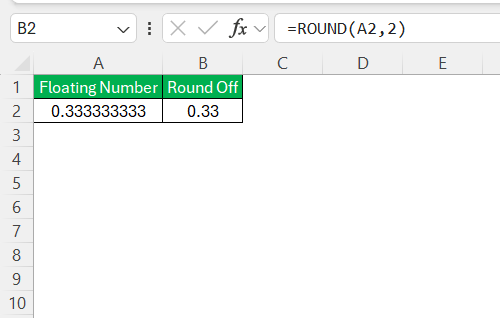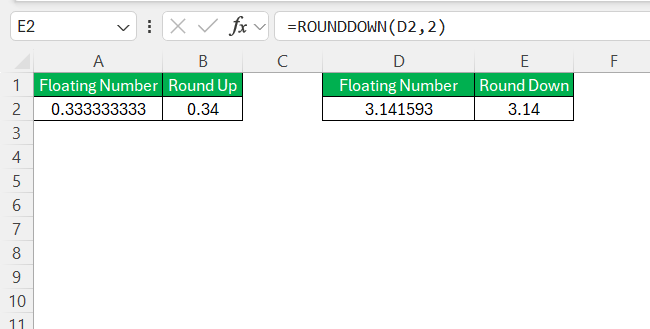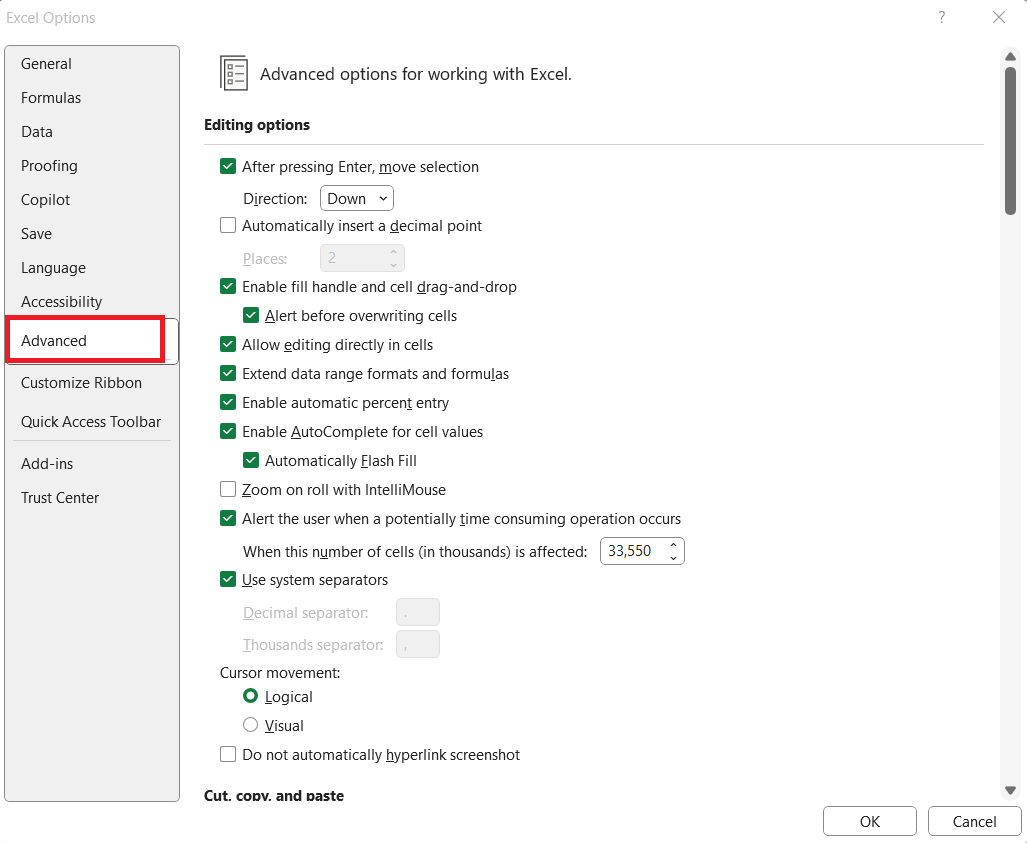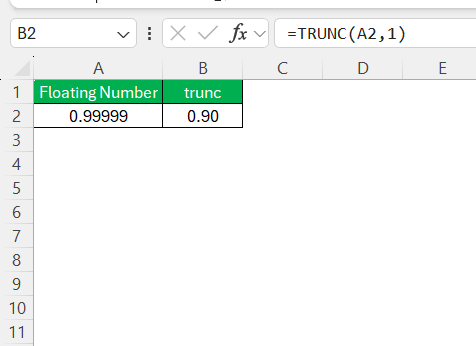I’ve been working with Excel for years. It’s my go-to tool for organizing data, crunching numbers, and building reports. But every now and then, I run into something that throws me off balance—floating point errors. Floating point errors can notoriously disrupt calculated values in Excel, leading to significant discrepancies, particularly in complex or financial datasets. Understanding and addressing these errors ensures the reliability and accuracy of Excel spreadsheets, which are crucial for informed decision-making.
Key Takeaways:
- Excel uses binary-based floating-point arithmetic, which cannot precisely represent some decimal values (like 0.1). This can result in small inaccuracies in otherwise simple calculations.
- Minor discrepancies from individual operations can compound over multiple calculations. This is especially problematic in large datasets or iterative processes where precision matters.
- Functions like ROUND, ROUNDUP, and ROUNDDOWN help manage decimal precision, ensuring consistency in results and reducing the impact of floating point errors.
- Enabling the “Set precision as displayed” feature forces Excel to calculate values exactly as shown on the screen, but this can permanently reduce data accuracy, so backups are recommended.
- Floating point errors can significantly impact financial calculations, data reporting, and analytical outcomes, potentially leading to poor decisions or compliance issues if not addressed properly.
Table of Contents
Understanding Floating Point Errors in Excel
What are Floating Point Errors?
Floating point errors in Excel arise from the program’s numerical representation system. Excel uses floating-point arithmetic to handle numerical values, which enables efficient use of memory and processing power by adjusting precision dynamically. However, this system uses binary, not decimal arithmetic.
As a result, certain decimal numbers cannot be precisely represented, leading to small miscalculations. These errors manifest as slight discrepancies in results, such as unexpected decimal places in straightforward arithmetic operations.
Common Causes of Floating Point Errors
Several factors contribute to floating point errors in Excel. Key among them is the binary representation of decimal numbers, which limits precision for certain values. Numbers like 0.1 cannot be perfectly captured, leading to rounding errors. Additionally, the cumulative effect of multiple calculations amplifies these minor inaccuracies.
Operations involving very large or very small numbers, or those requiring high precision, further exacerbate these errors due to the inherent constraints of floating-point arithmetic. Understanding these causes is essential for implementing corrective measures.
Techniques to Fix and Mitigate Errors
Rounding Strategies
Rounding strategies are vital tools in managing floating point errors in Excel. The ROUND function is particularly effective, allowing users to specify the number of decimal places for a calculation. By rounding numbers involved in operations, discrepancies due to excessive decimal places are minimized. For instance, using =ROUND(A2, 2) forces the result to adhere to two decimal places, ensuring consistency when comparing values.
Additionally, Excel provides functions like ROUNDUP and ROUNDDOWN, valid for specific rounding requirements, such as always rounding towards or away from zero.
Applying these strategies can improve accuracy and mitigate common floating point issues efficiently.
Using the Precision as Displayed Option
The Precision as Displayed option in Excel is an effective technique for handling floating point errors by aligning the numerical precision with the visible decimal place format. Activating this feature adjusts the internal calculations to match the displayed decimals, thus minimizing discrepancies.
To enable it, navigate to the File menu, select Options, and find the Advanced category.
Within the ‘When calculating this workbook’ section, choose the desired workbook and check the ‘Set precision as displayed’ box.
Although this method helps maintain consistency, it also permanently alters data precision to the displayed format, potentially impacting long-term data accuracy. Thus, it is recommended to save a backup before applying this option to safeguard original data
Leveraging Functions to Correct Errors
Excel offers a suite of functions designed to mitigate floating point errors effectively. One approach is using the TRUNC function, which truncates numbers to a specified number of decimal places without rounding, helping to manage precision issues.
Another powerful tool is the IF function, where conditional logic can be employed to adjust calculations based on the presence of minor discrepancies. When combined, these functions not only correct errors but also enhance the reliability of calculations across varied datasets. Leveraging these versatile Excel functions strategically can significantly streamline error correction processes and uphold data integrity.
Practical Implications of Floating Point Errors
Impact on Financial Calculations
In financial calculations, even minor floating point errors can have substantial implications. Precision is paramount in tasks such as interest computations, currency conversions, and investment analyses where accuracy affects financial outcomes and decisions. For example, rounding errors in compounded interest calculations can lead to significant variances over time, potentially resulting in misinformed strategies or loss in profit margins.
Moreover, discrepancies in financial reports may undermine stakeholder trust and impact regulatory compliance. Understanding these impacts underscores the necessity for rigorous error management, ensuring that financial data is both reliable and actionable. Employing effective techniques, like appropriate rounding and precision settings, helps mitigate such risks, preserving the credibility and accuracy of financial analyses.
Effects on Data Analysis and Reporting
Floating point errors can significantly skew data analysis and reporting outcomes by introducing inaccuracies that impact decision-making. Small discrepancies in datasets, accumulated through repeated calculations, may lead to misleading insights or trends. When conducting statistical analyses or generating detailed reports, such errors can compromise the integrity of conclusions drawn from data.
For instance, in large datasets, even minute errors can propagate, altering the results of critical metrics like averages, sums, and standard deviations. This can affect business strategies, as decisions based on flawed data may lead to suboptimal resource allocation or flawed predictions. Thus, ensuring precision and consistency in spreadsheets is vital to analyze data accurately, yielding reliable and actionable insights for stakeholders. Employing robust error mitigation techniques, such as custom functions and appropriate rounding methods, can help maintain the credibility of data analysis efforts.
FAQs
What exactly causes floating point errors in Excel?
Floating point errors are caused by Excel’s use of binary floating-point arithmetic. Since some decimal numbers (like 0.1 or 0.333) can’t be precisely represented in binary, Excel stores an approximation. This leads to small differences in results, particularly visible when performing multiple or complex calculations.
Why do my Excel results have unexpected decimal places?
This is often due to floating point errors where Excel stores slightly imprecise versions of numbers. Even simple operations like =0.1+0.2 may result in a value like 0.30000000000000004, which occurs because Excel stores and calculates in binary, not exact decimal.
How can I fix floating point errors in my spreadsheet?
You can mitigate errors using Excel’s rounding functions like ROUND, ROUNDUP, and ROUNDDOWN to control the number of decimal places. Another option is to enable the “Set precision as displayed” setting, which forces calculations to follow the visible number format—though it permanently changes values, so use with caution.
Do floating point errors matter in financial reports?
Yes, even tiny inaccuracies can have large financial implications over time. In scenarios like interest calculation or currency conversions, errors can accumulate and result in significant variances, which may affect compliance, profitability, or stakeholder trust if left unchecked.
Are there any functions in Excel designed to help with floating point issues?
Yes, Excel includes functions like TRUNC (to cut off digits without rounding) and IF (to apply conditional logic), which can be combined to correct discrepancies. These help in tailoring calculations to minimize precision issues and maintain consistency across data.
John Michaloudis is a former accountant and finance analyst at General Electric, a Microsoft MVP since 2020, an Amazon #1 bestselling author of 4 Microsoft Excel books and teacher of Microsoft Excel & Office over at his flagship MyExcelOnline Academy Online Course.












